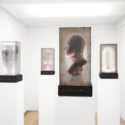MAGMA gallery opened recently a new show called “Renaissance”, featuring the work of three internationally renowned artists: Vhils, Betz and Gonzalo Borondo.
For the organisers, “Renaissance” is an important event. Not only because it is the gallery’s first exhibition after the lockdown, but also because it is the first time that MAGMA presents the work of these three great artists, and the first time Betz and Vhils show in Italy.
As expected, the exhibited artworks were created specially for the occasion and provide a personal interpretation of the concept of “Renaissance”.
Renaissance, (French: “Rebirth”) not only refers to the historic period in European civilization immediately following the Middle Ages and conventionally held to have been characterized by a surge of interest in Classical scholarship and values. It also makes reference to the capacity to renew oneself, find new paths, new energies from past experiences. When it comes to Portuguese artist, Alexandre Farto, aslo known as Vhils, the concept of rebirth comes through destruction. Emerging on the scene around 2007 his work, which mainly consists of chiseling away layers of walls using a variety of tools, made him an instant sensation.
When it comes to Portuguese artist, Alexandre Farto, aslo known as Vhils, the concept of rebirth comes through destruction. Emerging on the scene around 2007 his work, which mainly consists of chiseling away layers of walls using a variety of tools, made him an instant sensation.
An avid experimentalist, Vhils has been developing his personal aesthetics in a plurality of media besides his signature carving technique: from stencil painting to metal etching, from pyrotechnic explosions and video to sculptural installations.
From portraits that emerge from a collage of advertising posters to manually engraved wooden doors and etchings.  Known primarily for large-scale murals painted with Sainer as part of the Polish Etam Cru duo, Bezt‘s work is resistant to the ascription of excessively assigned meaning, preferring to allow the imagery to speak for itself. In his work, he juxtaposes saturated colors and loose brushstrokes with delicate, refined lines and patterns. For Renaissance, he created three large canvases that highlight his simple and quiet storytelling and where melancholic figures are depicted in familiar domestic scenes, blurring the lines between familiar and surreal narratives.
Known primarily for large-scale murals painted with Sainer as part of the Polish Etam Cru duo, Bezt‘s work is resistant to the ascription of excessively assigned meaning, preferring to allow the imagery to speak for itself. In his work, he juxtaposes saturated colors and loose brushstrokes with delicate, refined lines and patterns. For Renaissance, he created three large canvases that highlight his simple and quiet storytelling and where melancholic figures are depicted in familiar domestic scenes, blurring the lines between familiar and surreal narratives.  Spanish artist Gonzalo Borondo (born 1989), known for his haunting public art installations where the sacred and human nature are protagonists.
Spanish artist Gonzalo Borondo (born 1989), known for his haunting public art installations where the sacred and human nature are protagonists.
For the occasion he created a group of four sculptures made of printed and scratched layers of plexiglass, visually putting together and giving shape to four glass rectangles depicting four human temperaments: choleric, phlegmatic, sanguine, and melancholic.
Over time, glass has become the protagonist in Borondo’s work. A process between painting and engraving; paint being applied on the transparent canvas and then scratched away with sharp tools. The result? enigmatic and haunting.
Renaissance runs until November 28 at the gallery located on Via Santo Stefano n. 164, 40125 Bologna – Italy.
info@magma.gallery 



You must be logged in to post a comment.